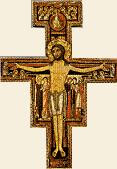This lecture is based on Ilia Delio’s article, ‘St. Francis Style of Prayer’ appearing on the Saint Anthony Messenger, October 2004.
Introduction: Our Relationship with God
Importance of language to speak to God:
-Distant and remote language = God is distant and remote
-Male language = God is male
-Humble and loving language = God is humble and loving
-Judgmental language = God is judgmental
-The God to whom I pray is the God who directs my life; thus my image of God, the kind of God I believe in, is crucial to the way my journey of prayer proceeds.
Group Sharing 1: Image of God
-Is God interested in me or is He distant?
-Is God primarily a severe judge or savior for me?
-Do I treat God as ruler or lover?
Image of God
In his book The Social God, Kenneth Leech looks at various images of God that have governed Christian belief throughout history. For example, those who believe in a transcendent, spiritual God who does not get involved with the messiness of the world believe that the material world is irrelevant because only truly spiritual activities are important. Prayer to this type of God can be self–centered and present peace, stillness and tranquility as ends in themselves.
Followers of a God who is not passionate about creation and therefore never becomes angry or jealous promote a nice, safe God of love, life and joy. Because Jesus is a nice guy, the reality of the passion and the role of God in our ambiguity, messiness and sin is avoided. These types are like the hippie flower children of the ’60s and ‘70s who always proclaimed that everything is beautiful and ‘all you need is love.’
On the other hand, some people perceive God as a fascist, distant and authoritarian. Prayer is highly structured and a duty—not real communication or personal relationship because God is a harsh judge who uses the world as a courtroom. These people often live in the fear of God’s judgment and eternal damnation (i.e., the pains of hell).
There are many other images but the bottom line is: The way we experience God is the way we experience the world and all that is in it. That is why to talk of a journey or path of prayer means talking about a particular way of experiencing God.
Growth in prayer is the measure of our journey to God. In the monastic tradition, the idea of journey meant that the created world motivates a person to turn inward in the search for God. In order to know true reality, a monk or nun had to transcend this world and contemplate the one above.
next...The Monastic Approach
Subscribe to:
Post Comments (Atom)











No comments:
Post a Comment